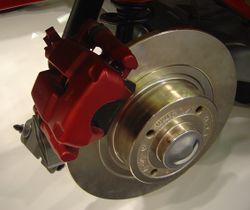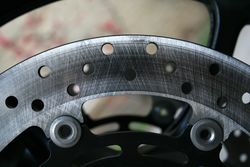Difference between revisions of "Disc brake"
(New page: thumb|Close-up of a disc brake on a car [[Image:2009-02-10 2008 Yamaha FZ6 front rotor close-up.jpg|thumb|A cross-drilled disc on a modern motorcycle...) |
|||
| Line 1: | Line 1: | ||
[[Image:Disk brake dsc03682.jpg|thumb|Close-up of a disc brake on a car]] | [[Image:Disk brake dsc03682.jpg|thumb|Close-up of a disc brake on a car]] | ||
[[Image:2009-02-10 2008 | [[Image:2009-02-10 2008 Yamaha FZ6 front rotor close-up.jpg|thumb|A cross-drilled disc on a modern [[motorcycle]] ([[Yamaha FZ6]])]] | ||
The disc [[brake]] or disk brake is a device for slowing or stopping the rotation of a wheel while it is in motion. A brake disc (or rotor in U.S. English) is usually made of cast iron, but may in some cases be made of composites such as reinforced carbon-carbon or ceramic-matrix composites. This is connected to the wheel and/or the axle. To stop the wheel, friction material in the form of brake pads (mounted on a device called a brake [[caliper]]) is forced mechanically, hydraulically, pneumatically or electromagnetically against both sides of the disc. Friction causes the disc and attached wheel to slow or stop. Brakes (both disc and drum) convert friction to heat, but if the brakes get too hot, they will become less effective because they cannot dissipate enough heat. This condition of failure is known as brake fade. | The disc [[brake]] or disk brake is a device for slowing or stopping the rotation of a wheel while it is in motion. A brake disc (or rotor in U.S. English) is usually made of cast iron, but may in some cases be made of composites such as reinforced carbon-carbon or ceramic-matrix composites. This is connected to the wheel and/or the axle. To stop the wheel, friction material in the form of brake pads (mounted on a device called a brake [[caliper]]) is forced mechanically, hydraulically, pneumatically or electromagnetically against both sides of the disc. Friction causes the disc and attached wheel to slow or stop. Brakes (both disc and drum) convert friction to heat, but if the brakes get too hot, they will become less effective because they cannot dissipate enough heat. This condition of failure is known as brake fade. | ||
[[Category:Definitions]] | [[Category:Definitions]] | ||
Revision as of 03:11, 26 May 2010
The disc brake or disk brake is a device for slowing or stopping the rotation of a wheel while it is in motion. A brake disc (or rotor in U.S. English) is usually made of cast iron, but may in some cases be made of composites such as reinforced carbon-carbon or ceramic-matrix composites. This is connected to the wheel and/or the axle. To stop the wheel, friction material in the form of brake pads (mounted on a device called a brake caliper) is forced mechanically, hydraulically, pneumatically or electromagnetically against both sides of the disc. Friction causes the disc and attached wheel to slow or stop. Brakes (both disc and drum) convert friction to heat, but if the brakes get too hot, they will become less effective because they cannot dissipate enough heat. This condition of failure is known as brake fade.

